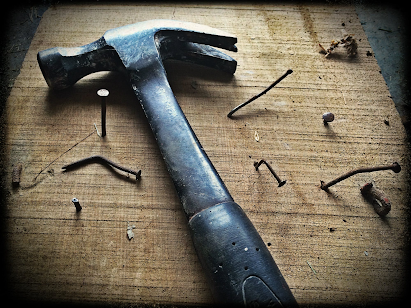The Shed: A memory of leadership
 |
| (CC) Black Claw Hammer on Brown Wooden Plank |
A place for everything and everything in its place
Our old house was once owned by a professional gardener. When he had lived there, he had only single glazing, bars on his windows, no central heating and no kitchen. He had cooked using a single gas hob in the little shed behind the house. Whilst small, this was not a rudementary setup, the garden was both irrigated and lit using a complex network of subterranean cables and piping which all led back to the shed. This man, as many men of his generation were prone to, spent an inordinate amount of his free time in his shed. It was the control centre of his realm, a place to tinker, to cook, to think, and to escape from the world.
A large workbench dominated the shed. As testimony to the years of thinking and tinkering, this bench was peppered with nails, all pointing in different directions and hammered in to lesser or greater degrees. Despite their number, it was clear that each nail had been purposefully positioned: to hold something in place, to hold something back, to suspend something, or as an anchor point for something else. There was something very particular and exact about each of them.
By the time I came along, the purpose of this hedgehog of metal had long been forgotten and instead of a help, I found they were a hinderance. I quickly lost count of how many times I bashed a wrist or a hip or caught my clothing on these. Eventually, in a pique, I set about removing every last one.
 |
| A pile of rusty nails |
Within weeks, as I setup the shed to my own preferences, I found myself ruefully wishing I had a nail here to hold this cord, or one there to stop that from moving...hindsight is a cruel yet wonderful thing.
In the end, when we came to sell the house, the home report declared that there was evidence of wood worm in the shed (a brick structure with concrete floor). Again, the lack of context causing issue. There was no evidence of wood worm, instead the holes in the bench were evidence of thought and effort, of efficiencies and routines, of trial and error, and ultimately, of the lack of understanding of all those legacy decisions.
How often do we make the same mistakes in our schools? Policies and decisions made in previous years still in place, despite the rationale, the arguments, and sometimes even the staff having all moved on.
Every year, we welcome new pupils, new staff and new parents to our school communities. How often do we get carried along on the wave of tradition and routine, that we forget that we must manage this change as we would any other meaningful change in the school, or risk spreading confusion, anxiety, frustration through this new section of our community?
 |
The Lippitt-Knoster Model for Managing Complex Change |
Staff, parents and pupils all require the same hand-holding to get up to speed with "the school way", to become comfortable with processes, names, remits and, yes, the apps on which we share school news and homework. We cannot expect them to simply arrive with the knowledge that established members of the community have taken time to build.
If we do not take time to have these conversations, we risk all those deliberate choices being unpicked and outsiders looking at our school may be mistaken for spotting signs of woodworm.
If we do not take time to have these conversations, we risk all those deliberate choices being unpicked and outsiders looking at our school may be mistaken for spotting signs of woodworm.
Comments
Post a Comment